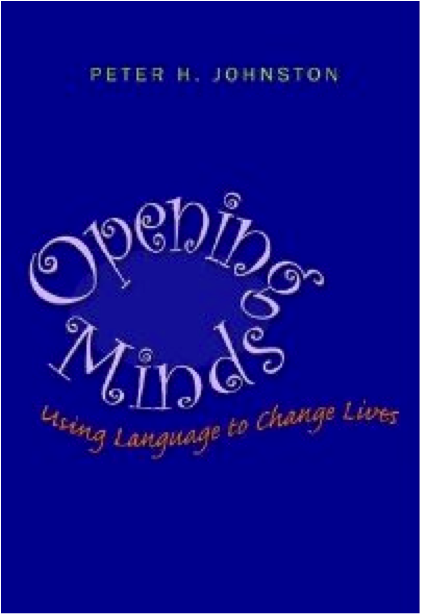A good friend from Alabama sent me a present in the mail the other day-Peter Johnston’s new book: Opening Minds: Using Language to Change Lives. I don’t think I have ever met him, although in graduate school I worked closely with a professor who was a friend of his and I had always hoped for the chance to be introduced. Sadly, that never came to pass. But, after reading Johnston’s latest book, I thought I should take a moment and write him a letter…
Dear Peter,
I have so enjoyed your latest book, Opening Minds: Using Language to Change Lives. Not only have I read it and thought deeply about it while reading, but I have also highlighted sections I want to use in workshops. I have already talked and texted about your ideas with colleagues and suggested your book to different groups of teachers as something they should be reading now. The study you cite by Neil Mercer and his colleagues fascinates me for how the research might inform our traditional model of schooling and our need to focus on the individual. You write:
In their study the children took the nonverbal reasoning test in groups of three, and then they took a different form of the test individually. Three months later, they took the tests again in groups and as individuals. In the meantime, half of them had been taught how to think together. As you would expect…the children who had learned to think together became more successful on the test in the group situation-their group IQ increased. In addition, when they subsequently took another version of the IQ test individually, the children who had learned to think together outperformed those who had not. In other words, the experiencing of thinking together productively in a mixed-ability group actually increased the individual children’s measured intelligence.
You might also be interested in the work of Keith Sawyer from Washington University in St. Louis. He was a student of Mihaly Csikszentmihaly who coined the term “flow.” Csikszentmihaly referred to creative individuals being in a state of flow; but Sawyer has taken his work a step further and writes about the value of “group flow” and with group flow comes more effective teamwork, greater innovation and higher workplace satisfaction-hence, the importance of professional learning communities in our profession!
Peter, I also wanted to share with you that several of the example lessons you describe in your book sound so much like the lessons we have written and include in our program Making Meaning. For example, Jesse Harrison’s class when they are reading the book The Summer My Father was Ten and the students turn and talk about what one of the characters was thinking; when Cheryl McMann’s students, after reading Stealing Home: Jackie Robinson Against the Odds, turn and talk about what Jackie’s actions tell us about him; and when Susie Althof’s kindergartners make eye contact to show their partner they are listening…all three are perfect examples of the work that we encourage teachers to do in our programs!
It really does seem that we have a lot we can learn from one another! Thanks for your brilliance-I really do look forward to meeting you one day!
Sincerely,
Isabel McLean

